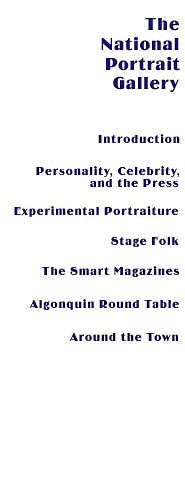







As writers, artists, and humorists arrived in New York City after World War I, the "smart magazines" of the era offered the best vehicles for original expression. Vanity Fair and the New Yorker set the pace, showcasing a fresh, urban attitude. The irreverent wit and light parody that they adopted was already pervading the Broadway stage, the vaudeville circuit, Tin Pan Alley, magazine verses, newspaper columns, and Greenwich Village costume balls.
Debonair editor Frank Crowninshield of Vanity Fair, a passionate advocate of modern art, humor, and celebrity, had, according to Robert Benchley, "a willingness for any writer who writes entertainingly, to say practically anything . . . so long as he says it in evening clothes." Pen and ink stylizations by Ralph Barton and Miguel Covarrubias perfectly suited his tone. In the 1930s, Vanity Fair critiqued celebrity culture with bold color caricatures by Covarrubias, Will Cotton, and Paolo Garretto. Caricature proved equally appealing to New Yorker editor Harold Ross, who, while promising a mood of gaiety, wit, and satire, also assumed a "reasonable degree of enlightenment" in his readers.
1. Irving Berlin / Miguel Covarrubias
2. Sally Rand and Martha Graham/ Miguel Covarrubias
3. Josephine Baker / Paolo Garretto
4. Lunch at the Astor/ Will Cotton
5. Harold Ross/ Rea Irvin
6. Charles Atlas/ Paolo Garretto